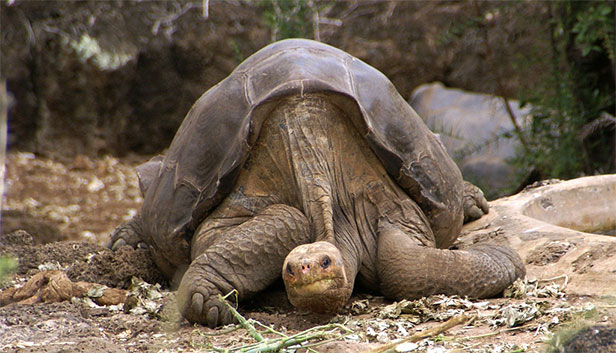Tortoise Revival Plan Blends Tech and Good-Old-Fashioned Babymaking
Extinct species of Galapagos tortoise are hiding in the gene pools of their sister species, just waiting for conservationists to tease them out. At least that’s the concept behind a multiyear plan to bring back the Pinta and Floreana Island giant tortoise species using a combination of genetic analysis and careful breeding.

This story begins in 2008 with the tagging and genetic analysis via blood sample of more than 1,500 tortoises living on Isabela Island, according to Sandra Blakeslee in the New York Times. Seventeen of the tortoises surveyed had high levels of Pinta tortoise DNA, a lineage which went extinct in 2012 with the death of the captive tortoise known as Lonesome George. George was a conservation celebrity, and a symbol of the fragile island ecosystems that inspired Charles Darwin’s theory of evolution.
Meanwhile, 89 others at least partially matched a genetic profile of the Floreana Island subspecies, which was thought to have been wiped out by hungry sailors not long after Darwin’s visit to the Galapagos.
A few even seemed like almost “purebred” Floreana tortoises, perhaps scions of the line that found their way to the island after being tossed overboard in the nearby bay. (Blakeslee has some excellent background on the nautical history of tortoise take-out in the 19th century, if you’re interested.)
This November the scientists returned to collect the tortoises that hold in their genes the echoes of their extinct kin. Thirty-two tortoises were airlifted off the island, according to Henry Nicholls’s report at Nature. Only seven of the animals identified in the 2008 survey were recovered; otherwise, the team worked visually, collecting tortoises with the most prominently saddle-shaped shells, a trait characteristic of the Pinta and Floreana species. One of the tortoises they found was reportedly a dead ringer for the late Lonesome George himself.
The plan now: carefully breed them in captivity to re-create, as much as possible, the unique genetics of the lost populations. “In just a few generations, it should be possible to obtain tortoises with 95 percent of their ‘lost’ ancestral genes,” Blakeslee writes.
This approach stands in contrast to the more dramatic “de-extinction” plans pushed by folks like Harvard geneticist George Church and the Long Now Foundation, a topic I’ve blogged about before for the Genetic Literacy Project. De-extinction hinges on genetic reconstruction and cloning. It’s technically possible to attempt to bring back any species that we have genetic material for, whether via museum specimens, as with the passenger pigeon, or via well-preserved hunks of meat, as with mammoths. Lonesome George is certainly well-preserved, having been frozen and taxidermied upon his demise, but there’s no plan to use cloning in this particular endeavor.
Instead, the scientists plan to use genetic analysis—particularly marker-assisted breeding, which is essentially classical breeding souped up with the ability to analyze the genomes of a different breeding partner and find genetic markers connected to the traits you want. Computer-built reconstructions of the Pinta and Floreana genomes will serve as targets for the breeding project, and computers make predicting the outcome of complex genetic crosses possible. Even if it’s unsuccessful, this project represents a milestone in the use of genetics to guide conservation: “[T]his is the first time that genetic information has been used so determinedly,” Linda Cayot, science adviser for the Galápagos Conservancy, told Blakeslee.
To be fair, a lost species’ existence can never be restored completely—there’s more to a species’ existence in ecological terms than its particular suite of genes—but the approximations created should be a better ecological fit for their native islands. Hopefully, through an artful mix of technology and good-old-fashioned babymaking, two of Darwin’s signature islands will see a bit of their unique evolutionary heritage returned.
Keep Reading
Most Popular
Large language models can do jaw-dropping things. But nobody knows exactly why.
And that's a problem. Figuring it out is one of the biggest scientific puzzles of our time and a crucial step towards controlling more powerful future models.
The problem with plug-in hybrids? Their drivers.
Plug-in hybrids are often sold as a transition to EVs, but new data from Europe shows we’re still underestimating the emissions they produce.
Google DeepMind’s new generative model makes Super Mario–like games from scratch
Genie learns how to control games by watching hours and hours of video. It could help train next-gen robots too.
How scientists traced a mysterious covid case back to six toilets
When wastewater surveillance turns into a hunt for a single infected individual, the ethics get tricky.
Stay connected
Get the latest updates from
MIT Technology Review
Discover special offers, top stories, upcoming events, and more.